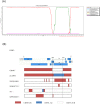Characterization of a novel HIV-1 unique recombinant form between CRF07_BC and CRF55_01B in men who have sex with men in Guangzhou, China
- PMID: 28403241
- PMCID: PMC5389846
- DOI: 10.1371/journal.pone.0175770
Characterization of a novel HIV-1 unique recombinant form between CRF07_BC and CRF55_01B in men who have sex with men in Guangzhou, China
Abstract
Here, we report the genetic diversity of HIV-1 and emergence of novel HIV-1 unique recombinant forms (URF) in both HIV-infected intravenous drug users (IDU) and men who have sex with men (MSM) in Guangzhou, China. We further characterized a novel URF strain isolated from an HIV-infected MSM, GD698. Near full-length genome (NFLG) phylogenic analysis showed that this novel URF was composed of CRF07_BC and CRF55_01B, with two recombinant breakpoints (nt 6,003 and 8,251 relative to the HXB2 genome) in the vpu/env and env genes, respectively. Twenty six percent of the genome is classified as CRF55_01B, spanning part of vpu and most of the env gene. The remaining 74% of the genome is classified as CRF07_BC. Both the backbone CRF07_BC sequence and CRF55_01B fragment were clustered with the HIV-1 isolates found in MSM. The emergence of the novel HIV-1 recombinant indicates the ongoing recombinants derived from the CRF07_BC and CRF55_01B isolates, and provides critical insights into our understanding of the dynamics and complexity of the HIV-1 epidemic in China.
Conflict of interest statement
Figures




References
-
- He X, Xing H, Ruan Y, Hong K, Cheng C, Hu Y, et al. A comprehensive mapping of HIV-1 genotypes in various risk groups and regions across China based on a nationwide molecular epidemiologic survey. PLoS One. 2012; 7(10): e47289 doi: 10.1371/journal.pone.0047289 - DOI - PMC - PubMed
-
- Zhang L, Wang YJ, Wang BX, Yan JW, Wan YN and Wang J Prevalence of HIV-1 subtypes among men who have sex with men in China: a systematic review. Int J STD AIDS. 2015; 26(5): 291–305. doi: 10.1177/0956462414543841 - DOI - PubMed
-
- Piyasirisilp S, McCutchan FE, Carr JK, Sanders-Buell E, Liu W, Chen J, et al. A recent outbreak of human immunodeficiency virus type 1 infection in southern China was initiated by two highly homogeneous, geographically separated strains, circulating recombinant form AE and a novel BC recombinant. J Virol. 2000; 74(23): 11286–95. - PMC - PubMed
MeSH terms
LinkOut - more resources
Full Text Sources
Other Literature Sources
Medical
Molecular Biology Databases
Research Materials

